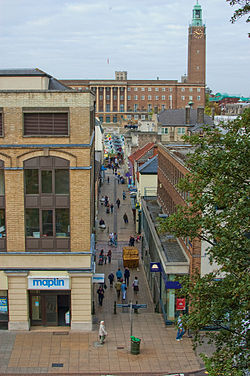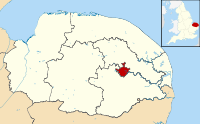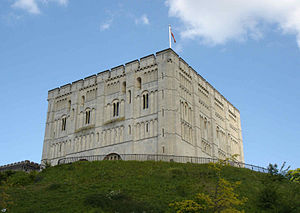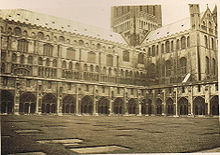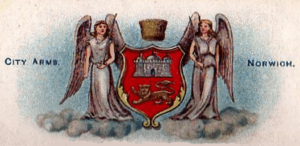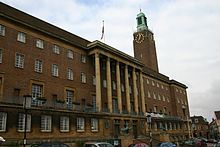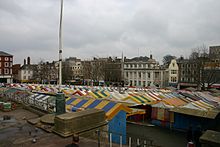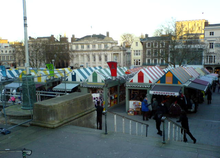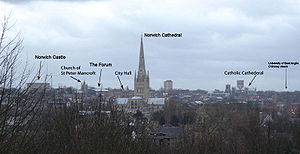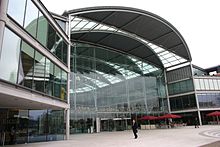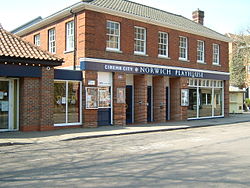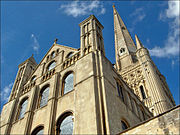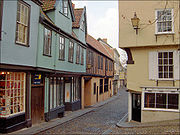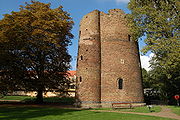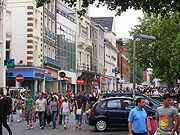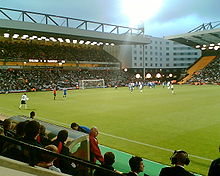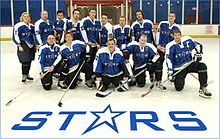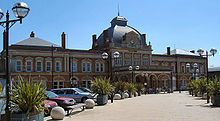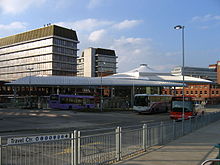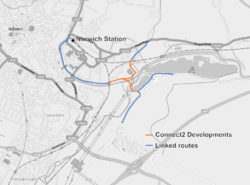- Norwich
-
City of Norwich Norwich city centre 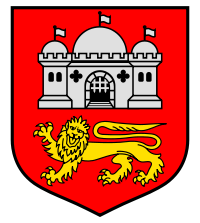
Coat of Arms of the City CouncilShown within Norfolk Coordinates: 52°37′42″N 1°17′48″E / 52.62833°N 1.29667°ECoordinates: 52°37′42″N 1°17′48″E / 52.62833°N 1.29667°E Country United Kingdom Constituent Country England Region East of England County Norfolk Government – Type Non-metropolitan district – Local Authority Norwich City Council – MPs Simon Wright (Liberal Democrats)
Chloe Smith (Conservative)Area – City 15.1 sq mi (39.02 km2) Population (2010 est.) – City 135,100 (Ranked 148th) – Urban 259,100 – Metro 376,500 (Travel to Work Area) – Ethnicity 93.2% White
1.4% Mixed race
2.3% South Asian
2.1% Chinese or other
1.0% Black.– Ethnicity Density 8,774.9/sq mi (3,388/km2) Time zone Greenwich Mean Time (UTC+0) Postcode NR1–NR16 Area code(s) 01603 ONS code 33UK Norwich (
 i/ˈnɒrɪdʒ/ norr-ij, RP /ˈnɒrɪtʃ/ norr-ich)[1] is a city in England. It is the regional administrative centre and county town of Norfolk. During the 11th century, Norwich was the largest city in England after London, and one of the most important places in the kingdom. Until the Industrial Revolution, Norwich as the capital of England's most populous and prosperous county, vied with Bristol as England's second city.
i/ˈnɒrɪdʒ/ norr-ij, RP /ˈnɒrɪtʃ/ norr-ich)[1] is a city in England. It is the regional administrative centre and county town of Norfolk. During the 11th century, Norwich was the largest city in England after London, and one of the most important places in the kingdom. Until the Industrial Revolution, Norwich as the capital of England's most populous and prosperous county, vied with Bristol as England's second city.The urban area of Norwich has a population of 259,100. This area extends beyond the city boundary, with extensive suburban areas on the western, northern and eastern sides, including Costessey, Hellesdon, Old Catton, Sprowston and Thorpe St Andrew. The parliamentary seats cross over into adjacent local government districts. 135,800 (2008 est.) people live in the City of Norwich and the population of the Norwich Travel to Work Area (i.e. the area of Norwich in which most people both live and work) is 367,035 (the 1991 figure was 351,340). Norwich is the fourth most densely populated local government district within the East of England with 3,480 people per square kilometre (8,993 per square mile).
Contents
History
Roman
The Romans had their regional capital at Venta Icenorum on the River Tas, about 5 miles (8.0 km) to the south of Norwich next to modern-day Caistor St Edmund, which fell into disuse around 450 AD. The Anglo-Saxons settled on the site of the modern city from around the 5th – 7th centuries[2] founding the towns of Northwic (from which Norwich gets its name), Westwic (at Norwich-over-the-Water) and the secondary settlement at Thorpe.[citation needed]
Early English and Norman Conquest
There are two suggested models of development for Norwich. It is possible that three separate early Anglo-Saxon settlements, one on the north of the river and two either side on the south, joined together as they grew or that one Anglo-Saxon settlement, on the north of the river, emerged in the mid-7th century after the abandonment of the previous three. The ancient city was a thriving centre for trade and commerce in East Anglia in 1004 AD when it was raided and burnt by Swein Forkbeard the Viking. Mercian coins and shards of pottery from the Rhineland dating to the 8th century suggest that long distance trade was happening long before this. Between 924–939 AD Norwich became fully established as a town because it had its own mint. The word Norvic appears on coins across Europe minted during this period, in the reign of King Athelstan. The Vikings were a strong cultural influence in Norwich for 40–50 years at the end of the 9th century, setting up an Anglo-Scandinavian district towards the north end of present day King Street. At the time of the Norman Conquest the city was one of the largest in England. The Domesday Book states that it had approximately twenty five churches and a population of between five and ten thousand. It also records the site of an Anglo-Saxon church in Tombland, the site of the Saxon market place and the later Norman cathedral. Norwich continued to be a major centre for trade, the River Wensum being a convenient export route to the River Yare and Great Yarmouth, which served as the port for Norwich. Quern stones, and other artefacts from Scandinavia and the Rhineland have been found during excavations in Norwich city centre which date from the 11th century onwards.
Norwich Castle was founded soon after the Norman Conquest.[3] The Domesday Book records that 98 Saxon homes were demolished to make way for the castle.[4] The Normans established a new focus of settlement around the Castle and the area to the west of it: this became known as the "New" or "French" borough, centred on the Normans' own market place which survives to the present day as Norwich Market.
In 1096, Herbert de Losinga, the Bishop of Thetford, began construction of Norwich Cathedral. The chief building material for the Cathedral was limestone, imported from Caen in Normandy. To transport the building stone to the cathedral site, a canal was cut from the river (from the site of present-day Pulls Ferry), all the way up to the east wall. Herbert de Losinga then moved his See there to what became the cathedral church for the Diocese of Norwich. The bishop of Norwich still signs himself Norvic.
Norwich received a royal charter from Henry II in 1158, and another one from Richard the Lionheart in 1194. Following a riot in the city in 1274, Norwich has the distinction of being the only English city to be excommunicated by the Pope.[5]
Middle Ages
In 1144, the Jews of Norwich were accused of ritual murder after a boy (William of Norwich) was found dead with stab wounds. This was the first incidence of blood libel against Jews in England. The story was turned into a cult, William acquiring the status of martyr and subsequently being canonised. The cult of St William attracted large numbers of pilgrims, bringing wealth to the local church. On 6 February 1190, all the Jews of Norwich were massacred except for a few who found refuge in the castle.
At the site of a mediæval well, the bones of 17 individuals, including 11 children, were found in 2004 by workers preparing the ground for construction of a Norwich shopping centre. The remains were determined by forensic scientists to most probably be the remains of Jews murdered in the 12th century, and a DNA expert determined that the victims were all related, most probably coming from one Ashkenazi Jewish family.[6] The study of these remains was featured in an episode of the BBC television documentary series History Cold Case.[7]
The engine of trade was wool from Norfolk's sheepwalks. Wool made England rich, and the staple port of Norwich "in her state doth stand With towns of high'st regard the fourth of all the land", as Michael Drayton noted in Poly-Olbion (1612). The wealth generated by the wool trade throughout the Middle Ages financed the construction of many fine churches; consequently, Norwich still has more medieval churches than any other city in Western Europe north of the Alps. Throughout this period Norwich established wide-ranging trading links with other parts of Europe, its markets stretching from Scandinavia to Spain and the city housing a Hanseatic warehouse. To organise and control its export to the Low Countries, Great Yarmouth, as the port for Norwich, was designated one of the staple ports under terms of the 1353 Statute of the Staple.
By the middle of the 14th century the city walls, about two and a half miles (4 km) long, had been completed. These, along with the river, enclosed a larger area than that of the City of London. However, when the city walls were constructed it was made illegal to build outside them, inhibiting expansion of the city.
Around this time, the city was made a county corporate and became capital of one of the most densely populated and prosperous counties of England.
Early Modern Period (1485–1640)
Hand-in-hand with the wool industry, this key religious centre experienced a Reformation significantly different to other parts of England. Muriel McClendon describes a Tudor Norwich whose magistracy unusually found ways of managing religious discord whilst maintaining civic harmony.[8]
The year 1549 saw an unprecedented urban rebellion, which unlike popular challenges elsewhere in the Tudor period, appears to have been Protestant in nature. For several weeks Kett's rebels took control of industrial Norwich in support of cloth workers suffering the hunger associated with a deep trade recession. Unusually in England it divided a city and appears to have linked Protestantism with the plight of the urban poor. In the case of Norwich this process was underscored by the arrival of Dutch and Flemish 'Strangers' fleeing Catholic persecution and eventually numbering as many as one third of the city's population.[9] Perhaps in response to Kett, Norwich became the first provincial city to initiate compulsory payments for a civic scheme of poor relief, which Pound claims led to its wider introduction, forming the basis of the later Elizabethan Poor Law of 1597–8.[10]
The great 'Stranger' immigration of 1567 brought a substantial Flemish and Walloon community of Protestant weavers to Norwich, where they are said to have been made welcome.[11] Norwich has traditionally been the home of various dissident minorities, notably the French Huguenot and the Belgian Walloon communities in the 16th and 17th centuries. The merchant's house—now a museum—which was their earliest base in the city is still known as 'Strangers' Hall'. It seems that the Strangers were integrated into the local community without a great deal of animosity, at least among the business fraternity who had the most to gain from their skills. The arrival of the Strangers in Norwich bolstered trade with mainland Europe, fostering a movement toward religious reform and radical politics in the city.
The Norwich Canary was first introduced into England by Flemish refugees fleeing from Spanish persecution in the 16th century. They brought with them not only advanced techniques in textile working but also their pet canaries, which they began to breed locally, the little yellow bird eventually to become, in the 20th century, the city's most beloved mascot. The canary is the emblem of the city's football club, Norwich City F.C., nicknamed "The Canaries".
Printing was introduced to the city by Anthony de Solempne, one of the 'Strangers' in 1567 but did not become established and had died out by about 1572.[12]
English Civil Wars to Victorian Era
Across the Eastern Counties Cromwell's powerful Eastern Association was eventually dominant. However, to begin with, there had been a large element of Royalist sympathy within Norwich, which seems to have experienced a continuity of its two-sided political tradition throughout the civil-war period. Bishop Matthew Wrenn was a forceful supporter of Charles I; nonetheless Parliamentary recruitment took hold, and a strong Royalist party was stifled by a lack of commitment from the aldermen, and isolation from Royalist-held regions.[13] Serious inter-factional disturbances culminated in 'The Great Blow' of 1648 when Parliamentary forces tried to quell a Royalist riot. The latter's gunpowder was set off by accident in the city centre, causing mayhem. (According to Hopper qv, the explosion 'ranks among the largest of the century'.)Stoutly defended though East Anglia was by the parliamentary army, there are said to have been pubs in Norwich where the King's health was still drunk and the name of the Protector sung to ribald verse.
At the cost of some discomfort to the Mayor, a Royalist, and the bishop, Joseph Hall, a moderate, was targeted because of his position as bishop.[citation needed]
Distinguishing Norwich in the period following the Restoration of 1660 and throughout the ensuing century was that it was the golden age of its cloth industry, comparable only to those of the West Country and Yorkshire.[14] But unlike other cloth-manufacturing regions, Norwich weaving brought greater urbanisation; being substantially concentrated in the surrounds of the city itself, creating an urban society, with features such as leisure time, alehouses, and other public fora which provided opportunities for debate and argument.[15]
Writing of the early-18th century Pound describes the city's rich cultural life, the winter-theatre season, the festivities accompanying the summer assizes, and other popular entertainments. Norwich was the wealthiest town in England with a sophisticated poor-relief system, and a large influx of foreign refugees.[16] Despite having suffered severe episodes of plague, the city had a population of almost 30,000. Whilst this made Norwich unique in England it placed her in the company of about fifty cities in Europe. In some, like Lyon or Dresden, this was, as in the case of Norwich, linked to an important proto-industry, such as textiles or china pottery; in some, such as Vienna, Madrid or Dublin,to the city's status as an administrative capital; in others such as Antwerp, Marseilles or Cologne to its positioning on an important trade route of sea or river.[17]
However Norwich of the late-17th century was as ever riven politically. Humphrey Prideaux, dean of the cathedral in 1681, described 'two factions, Whig and Tory...and both contend for their way with the utmost violence'.[18] Nor did the city accept the outcome of the 1688 Glorious Revolution with a unified voice. The pre-eminent citizen, Bishop William Lloyd, would not take the oaths of allegiance to the new monarchs. One report has it that in 1704 the landlord of Fowler's alehouse 'with a glass of beer in hand, went down on his knees and drank a health to James the third, wishing the Crowne (sic) well and settled on his head'[19] 'Never was a city in the miserable kingdom so wretchedly divided as this' said the London Post.[20]
In 1716, at a play at the New Inn, the Pretender was cheered and the audience booed and hissed every time King George's name was mentioned. In 1722 supporters of the king were said to be 'hiss'd at and curst as they go in the streets', and in 1731 'a Tory mobb, in a great body, went through several parts of this city, in a riotous manner, cursing and abusing such as they knew to be friends of the government'.[21] But the Whigs gradually gained control and by the 1720s they had successfully petitioned parliament to allow all adult males working in the textile industry to take up the freedom, on the correct assumption that they would vote Whig. But it had the effect of boosting the city's popular Jacobitism, says Knights (qv),and contests of the kind described continued in Norwich well into a period in which political stability had been discerned at a national level, and the city's Jacobitism perhaps only ended from 1745, well after it had ceased to be a significant movement outside of Scotland.[22] Despite the Highlanders reaching Derby, and Norwich citizens mustering themselves into an association to protect the city, some Tories refused and the vestry of St Peter Mancroft resolved that it would not ring its bells to summon the defence. But it was the end of the road for Norwich Jacobites, and the Whigs organised a massive celebration following Culloden.[23]
What the events of this period illustrate is that precursory to an organised radical movement Norwich had had a strong tradition of popular protest favouring Church and Stuarts and attached to the street and alehouse. Knights qv tells how in 1716 the mayoral election had ended in a riot, 'with both sides throwing 'brick-ends and great paving stones' at each other.[24] A renowned Jacobite watering-hole, the Blue Bell Inn (nowadays The Bell Hotel), owned in the early-18th century by the high-church Helwys family, in the 1790s became the central rendez-vous point of the Norwich Revolution Society![25]
Britain's first provincial newspaper, the Norwich Post , had been published in 1701. By 1726 there were rival Whig and Tory presses and even in mid-century some parishes had three quarters of the males as literate.[26] In Norwich alehouses 281 clubs and societies met in 1701, and at least 138 more were formed before 1758. The Theatre Royal had opened in 1758 adding to the city's stage productions in inns, and puppet shows in rowdy alehouses.[27] In 1750 Norwich could boast nine booksellers and after 1780 a 'growing number of circulating and subscription libraries'.[28] Knights says: '[All this] made for a lively political culture, in which independence from governmental lines was particularly strong, evident in campaigns against the war with America and for reform...in which trade and the impact of war with Revolutionary France were key ingredients. The open and contestable structure of local government, the press, the clubs and societies, and dissent all ensured that politics overlapped with communities bound by economics, religion, ideology and print in a world in which public opinion could not be ignored.'[29]
Amidst this metropolitan culture the city burghers had built a sophisticated political structure. Freemen, who not only had the right to trade but to vote at elections, numbered about 2,000 in 1690, rising to over 3,300 by the mid-1730s. With growth partly the result of political manipulation, their numbers did at one point reach one third of the adult male population.[30] This was notoriously the age of 'rotten' and 'pocket' boroughs, and Norwich was unusual in having such a high proportion of its citizens able to vote. 'Of the political centres where the Jacobin propaganda had penetrated most deeply', says E.P.Thompson, 'only Norwich and Nottingham had a franchise deep enough to allow radicals to make use of the electoral process.'[31] 'Apart from London, Norwich was probably still the largest of those boroughs which were democratically governed', says Jewson, describing other towns under the control of a single fiefdom. In Norwich, he says, a powerful Anglican Establishment, symbolised by the Cathedral and the great church of St Peter Mancroft was matched by scarcely less powerful congeries of Dissenters headed by the wealthy literate body [of Unitarians] worshipping at the Octagon Chapel.'[32]
Moreover in the midst of political disorders of the late-18th century, Norwich intellectual life flourished. And it contained one, so far unmentioned, characteristic. Harriet Martineau writes of the city's literati of the period, which included such people as William Taylor, one of the first German scholars in England. The city 'boasted of her intellectual supper-parties, where, amidst a pedantry which would now make laughter hold both his sides, there was much that was pleasant and salutary: and finally she called herself The Athens of England.[33]
Notwithstanding Norwich's hitherto industrial prosperity, by the 1790s the wool trade was experiencing intense competition. It came from both Yorkshire woollens, and increasingly from Lancashire cottons. The effects were aggravated by the loss of continental markets after Britain went to war with France in 1793.[34] The early-19th century would see deindustrialisation accompanied by bitter squabbles. The 1820s would be marked with wage cuts and personal recrimination against owners. Thus amid the rich commercial and cultural heritage that was its recent past, there lurked in the alleys of 1790s Norwich an unwelcome stranger, incipient decline; exacerbated by a serious trade recession.
As early in the war as 1793 a major city manufacturer and government supporter, Robert Harvey, had complained of low order books, languid trade and a doubling of the poor rate.[35] As with many generations of their Norwich forbears, the hungry poor took their complaints on to the streets. Hayes describes a meeting of 200 people in a Norwich public house, at which 'Citizen Stanhope' spoke.[36] The gathering is said to have '[roared its] applause at Stanhope's declaration that the Ministers, unless they changed their policy ' deserved to have their heads brought to the block; – and if there was a people still in England, the event might turn out to be so.' Hayes says that 'the outbreak of war, in bringing the worsted manufacture almost to a standstill and so plunging the mass of the Norwich weavers into sudden distress made it almost inevitable that a crude appeal to working-class resentment should take the place of a temperate process of education which the earliest reformers had intended'.[37]
However by 1795 it was not just the Norwich rabble which was causing the government concern. In April that year the Norwich Patriotic Society was established, its manifesto declaring 'that the great end of civil society was general happiness; that every individual...had a right to share in the government...'[38] In December the price of bread reached its highest yet, and in May 1796, when William Windham was forced to seek re-election following his appointment as war secretary, he only just held his seat.[39] Amid the same disorder and violence as was often the case with Norwich elections, it was only by the narrowest of margins that the radical Bartlett Gurney, campaigning on the platform of: 'Peace and Gurney – No More War – No more Barley Bread'failed to unseat him.[40]
Though informed by issues of recent national importance, the vibrant two-sided political culture of Norwich in the 1790s cannot be totally disconnected from local tradition.Two features stand out from a political continuum of three centuries. The first is the dichotomous power balance. From at least the time of the Reformation, there is a record of Norwich as a 'two-party city'. In the mid-16th century the weaving parishes actually fell under the control of opposition forces, as Kett's rebels held the north of the river, in support of poor cloth workers.
Secondly there does seem to be some case for saying that with this tradition of two-sided disputation, the city had over a long period of time developed an infrastructure, evident in her many cultural and institutional networks of politics, religion, society, news media and the arts, whereby argument could be managed short of outright confrontation. indeed at a time of hunger and tension on the Norwich streets, with the alehouse crowds ready to have 'a Minister's head brought to the block', that, unusually in England, the Anglican and Dissenting clergy were doing their best to conduct a collegiate dialogue, seeking common ground, and reinforcing the same well-mannered civic tradition of consensus as that illustrated by historians of earlier periods.
In 1797 Thomas Bignold, a 36-year-old wine merchant and banker, founded the first Norwich Union Society. Some years earlier, when he moved from Kent to Norwich, Bignold had been unable to find anyone willing to insure him against the threat from highwaymen. With the entrepreneurial thought that nothing was impossible, and aware that in a city built largely of wood the threat of fire was uppermost in people's minds, Bignold formed the "Norwich Union Society for the Insurance of Houses, Stock and Merchandise from Fire". The new business, which became known as the Norwich Union Fire Insurance Office, was a "mutual" enterprise. Norwich Union was later to become the country's largest insurance giant.
From earliest times, Norwich was a centre of textile manufacture. Towards the end of the 18th century, in the 1780s, the manufacture of Norwich shawls became an important industry[41] and remained so for nearly one hundred years. The shawls were a high-quality fashion product and rivalled those made in other towns such as Paisley (which entered shawl manufacture in about 1805, some 20 or more years after Norwich). With changes in women's fashion in the later Victorian period, the popularity of shawls declined and eventually manufacture ceased. Examples of Norwich shawls are now highly sought after by collectors of textiles.[42]
Norwich's geographical isolation was such that until 1845 when a railway connection was established, it was often quicker to travel to Amsterdam by boat than to London.<citation needed> The railway was introduced to Norwich by Morton Peto, who also built the line to Great Yarmouth.
From 1808 to 1814 Norwich hosted a station in the shutter telegraph chain which connected the Admiralty in London to its naval ships in the port of Great Yarmouth.
20th century
In the early part of the 20th century Norwich still had several major manufacturing industries. Among these were the manufacture of shoes (for example the Start-rite or Van Dal brands), clothing, joinery, and structural engineering as well as aircraft design and manufacture. Important employers included Boulton & Paul, Barnards (inventors of machine produced wire netting), and electrical engineers Laurence Scott and Electromotors.
Norwich also has a long association with chocolate manufacture, primarily through the local firm of Caley's, which began as a manufacturer and bottler of mineral water and later diversified into making chocolate and Christmas crackers. The Caley's cracker-manufacturing business was taken over by Tom Smith[43] in 1953, and the Norwich factory in Salhouse Road eventually closed down in 1998. Caley's was acquired by Mackintosh in the 1930s, and merged with Rowntree's in 1969 to become Rowntree-Mackintosh. Finally, it was bought by Nestlé and closed down in 1996 with all operations moved to York; ending a 120-year association with Norwich. The demolished factory stood on the site of what is now the Chapelfield development. Caley's chocolate has since made a reappearance as a brand in the city, although it is no longer made in Norwich.[44]
HMSO, once the official publishing and stationery arm of the British government and one of the largest print buyers, printers and suppliers of office equipment in the UK, moved most of its operations from London to Norwich in the 1970s.
Jarrolds, established in 1810, was a nationally well-known printer and publisher. In 2004, after nearly 200 years, it passed out of family ownership. Today, the Jarrold name is now best-known and recognised as being that of Norwich's only independent department store.[45]
The city was home to a long-established tradition of brewing,[46] with several large breweries continuing in business into the second half of the century. The main brewers were Morgans, Steward and Patteson, Youngs Crawshay and Youngs, Bullard and Son, and the Norwich Brewery. Despite takeovers and consolidation in the 1950s and 1960s in attempts to remain viable, by the 1970s only the Norwich Brewery (owned by Watney Mann and on the site of Morgans) remained. In 1985 the Norwich Brewery closed, and was subsequently demolished. Small-scale brewing continues in Norwich in "microbreweries".
Norwich suffered extensive bomb damage during World War II, affecting large parts of the old city centre and Victorian terrace housing around the centre. Industry and the rail infrastructure also suffered. The heaviest raids occurred on the nights of 27/28th and 29/30 April 1942; as part of the Baedeker raids (so called because Baedeker's series of tourist guides to the British Isles were used to select propaganda-rich targets of cultural and historic significance rather than strategic importance). Lord Haw-Haw made reference to the imminent destruction of Norwich's new City Hall (completed in 1938), although in the event it survived unscathed. Significant targets hit included the Morgan's Brewery building, Coleman's Wincarnis works, City Station, the Mackintosh chocolate factory, and shopping areas including St. Stephen's Street, St. Benedict's Street, the site of Bond's department store (now John Lewis) and Curl's department store (now Debenhams).
In 1976 the city's pioneering spirit was on show when Motum Road in Norwich, allegedly the scene of "a number of accidents over the years", became the third road in Britain to be equipped with "speed bumps", intended to encourage adherence to the road's 30 mph (48 km/h) speed limit.[47] The humps, installed at intervals of 50 and 150 yards, stretched twelve feet across the width of the road and their curved profile was, at its highest point, 4 inches (10 cm) high.[47] The responsible quango gave an assurance that the experimental devices would be removed not more than one year following installation.[47]
Governance
Since 1974, Norwich has had two tiers of local government. The upper tier is Norfolk County Council, which provides "wide area" strategic services such as education, social services and libraries. The lower tier is Norwich City Council, which provides more local services such as housing, planning and leisure facilities.[48]
County council
Norwich returns 13 county councillors to the eighty-four member county council. The city is divided into single-member electoral divisions, with all county councillors elected every four years.[49] The most recent county elections in 2009 saw the election of 6 Green Party, 3 Liberal Democrat, 2 Labour Party and 2 Conservative councillors. The county council has a large Conservative majority.[50]
City council
Norwich City Council consists of 39 councillors, 3 representing each of 13 wards. Elections are held by thirds, with one councillor in each ward being elected annually (for a four year term) except in the year of county council elections.[51] As of February 2010 the strength of parties on the council was: Labour Party 15, Green Party 13, Liberal Democrats 6 and Conservatives 5.[52] The Labour Party forms a minority administration, holding all seats on the eight-member executive.[53] Following the High Court decision that the order for a unitary council was unlawful, the 13 councillors who should have stood at the May election were told that they were no longer councillors. An election for these 13 seats was held on 9 September 2010. The Conservatives lost one seat to Labour, and the Liberal Democrats lost one seat to the Greens, resulting a new council composition of 16 Labour, 14 Green, five Liberal Democrat and four Conservative.[54]
The current composition, as of the 5 May 2011 council elections, is:
Party[55] Seats Labour 18 Green 15 Liberal Democrat 4 Conservative 2 Lord mayoralty and shrievalty
The civic head of Norwich City Council is the Lord Mayor. The office of mayor of Norwich dates from 1403.[56] The office was raised to the dignity of lord mayor in 1910 by Edward VII "in view of the position occupied by that city as the chief city of East Anglia and of its close association with His Majesty"[57] The title was regranted on local government reorganisation in 1974.[58]
From 1404 the citizens of Norwich, as a county corporate, had the privilege of electing two sheriffs. Under the Municipal Corporations Act 1835 this number of sheriffs was reduced to one, and it became an entirely ceremonial post. Both lord mayor and sheriff are elected at the council's annual meeting.[56][59]
Coat of arms
The city council's arms consist of a red shield on which is placed a silver domed castle above a royal lion.[60][61][62] The blazon of the arms is:
Gules, a castle triple-towered and domed Argent; in base a lion passant guardant Or.[60][62]
The arms appeared on a 15th century seal, and were confirmed during a heraldic visitation in 1562 by William Harvey, Clarenceux King of Arms. The royal lion was, according to Wilfrid Scott-Giles, "said to have been granted by Edward III".[61] By the 19th century the city corporation had added supporters, two angels, to the arms, which were surmounted by a fur cap. These apparently originated in a carving of about 1534 outside Norwich Guildhall. A C Fox Davies noted that "whether or not these figures were then intended for heraldic supporters is a matter for dispute. At any rate there is no official authority for their use".[62]
Local government reform in 1974 saw the abolition of the county borough of Norwich and its replacement by a new Norwich City Council. An Order in Council transferred the ancient coat of arms (the shield alone) to the present authority.[63] The city council has also received the grant of an heraldic badge, depicting the seal of 1404 encircled by the lord mayor's chain.[64]
Unitary status – proposal and failure
In October 2006, the Department for Communities and Local Government produced a Local Government White Paper inviting councils to submit proposals for unitary restructuring. Norwich submitted its proposal in January 2007, which was rejected in December 2007, as it did not meet all the rigorous criteria for acceptance. In February 2008, the Boundary Committee for England, (from 1 April 2010 incorporated in the Local Government Boundary Commission for England), was then asked to consider alternative proposals for the whole or part of Norfolk, including whether Norwich should become a unitary authority, separate from Norfolk County Council. In December 2009, the Boundary Committee recommended a single unitary authority covering all of Norfolk, including Norwich.[65][66][67][68]
However, on 10 February 2010, it was announced that, contrary to the December 2009 recommendation of the Boundary Committee, Norwich would be given separate unitary status.[69] The proposed change was strongly resisted, principally by Norfolk County Council and the Conservative opposition in Parliament.[70] Reacting to the announcement, Norfolk County Council issued a statement that it would seek leave to challenge the decision in the courts.[71] A letter was leaked to the local media, in which the Permanent Secretary for the Department for Communities and Local Government noted that the decision did not meet all the criteria and that the risk of it "being successfully challenged in judicial review proceedings is very high".[72] The Shadow Local Government and Planning Minister, Bob Neill, stated that should the Conservative Party win the 2010 general election, they would reverse the decision.[73]
Following the 2010 general election, Eric Pickles was appointed Secretary of State for Communities and Local Government on 12 May 2010 in a Conservative–Liberal Democrat coalition government. According to press reports, he instructed his department to take urgent steps to reverse the decision and maintain the status quo in line with the Conservative Party manifesto.[74][75] However, the unitary plans were supported by the Liberal Democrat group on the city council, and by Simon Wright, LibDem MP for Norwich South, who intended to lobby the party leadership to allow the changes to go ahead.[76]
The Local Government Act 2010 to reverse the unitary decision for Norwich (and Exeter and Suffolk) received Royal Assent on 16 December 2010. The disputed award of unitary status had meanwhile been referred to the High Court, and on 21 June 2010 the court (Mr. Justice Ouseley, judge) ruled it unlawful, and revoked it. The city has therefore failed to attain permanent unitary status.[77]
Parliamentary representation
Since 1298, Norwich has been represented in the parliament by two members of parliament. Until 1950 the city was an undivided constituency, returning two MPs. Since that date the area has been divided between two single-member constituencies: Norwich North and Norwich South.[78]
Both constituencies have proved to be marginal seats in recent elections; until 2010 switching between the Labour and Conservative parties:
- Norwich North, which includes some rural wards of Broadland District, was held by Labour from 1966 to 1983 when it was gained by the Conservatives. Labour regained the seat in 1997, holding it until a by-election in 2009. The current MP is the Conservative, Chloe Smith.[79]
- Norwich South, which includes part of South Norfolk District, was held by Labour from 1966 to 1983 when it was gained by the Conservatives. Labour regained the seat in 1992, with Charles Clarke as the incumbent MP.[80] In the 2010 General Election, Labour lost the seat to the Liberal Democrats, with Simon Wright becoming MP.[81]
Economy
The city's economy, originally chiefly industrial with shoemaking a large sector, has changed throughout the eighties and nineties to a service-based economy. Aviva (formerly known as Norwich Union) still dominates these, but has been joined by other insurance and financial services companies.
New developments on the former Boulton and Paul site include the Riverside entertainment complex with nightclubs and other venues featuring the usual national leisure brands. Nearby, the football stadium is being upgraded with more residential property development alongside the river Wensum.
Archant, formerly known as Eastern Counties Newspapers (ECN) is a national publishing group that has grown out of the city's local newspaper, the Norwich Evening News and the regional Eastern Daily Press (EDP).
Norwich has long been associated with the manufacture of mustard. The world famous Colman's brand, with its yellow packaging, was founded in 1814 and continues to operate from its factory at Carrow. Colman's is now being exported world wide by its parent company Unilever (Unilever UK Export) putting Norwich on the map of British heritage brands. The Colman's Mustard Shop, which sells Colman's products and related gifts, is located in the Royal Arcade in the centre of Norwich.
Norwich's night-time economy of bars and nightclubs is mainly located in Tombland, Prince of Wales Road and the Riverside area adjacent to Norwich railway station.
Retail
Norwich was the eighth most prosperous shopping destination in the UK in 2006.[82] Norwich has an ancient market place, established by the Normans between 1071 and 1074, which is today the largest six-days-a-week open-air market in England. The market has recently been downsized and undergone redevelopment, and the new market stalls have proved controversial: with 20% less floorspace than the original stalls, higher rental and other charges, and inadequate rainwater handling, they have been unpopular with many stallholders and customers alike. Indeed, the local Norwich Evening News characterises Norwich Market as an ongoing conflict between the market traders and Norwich City Council, which operates the market.[83]
The Mall Norwich (Castle Mall until 2007), a shopping mall designed by local practice Lambert, Scott & Innes and opened in 1993, presents an ingenious solution to the problem of sensitively accommodating new retail space in a historic city-centre environment—the building is largely concealed underground and built into the side of a hill, with a public park created on its roof in the area south of the Castle.
The new Chapelfield shopping mall has been built on the site where the Caleys (later Rowntree Mackintosh and Nestlé) chocolate factory once stood. Chapelfield opened in September 2005, featuring as its flagship department store House of Fraser. Detractors have criticised Chapelfield as unnecessary and damaging to local businesses; its presence has prompted smaller retailers to band together to promote the virtues of independent shops. Despite this in August 2006 it was reported by the Javelin Group that Norwich was one of the top five retail destinations in the UK,[84] and in October 2006 the city centre was voted the best in the UK, in a shopping satisfaction survey run by Goldfish Credit Card.[85]
To the north of the city centre is the Anglia Square shopping centre. The centre and the surrounding area is to be redeveloped; demolition work was due to commence in 2010 after an archaeological dig (conducted in 2009 and due to the centre being located around the site of a Saxon fortified settlement). The new development is planned to be a mixture of shops and housing, unlike the original which consisted of offices, shops and a cinema.[86] In February, 2009, it was announced that, due to the economic climate, plans for the area have been delayed and the developers are unable to say for certain when work will commence.[87]
Culture
The University of East Anglia on the outskirts of Norwich is, contrary to popular belief, not one of the so-called plate glass universities. The UEA along with Sussex University were both founded before Robbins Report. UEA was founded in 1963, before the Robbins Report. UEA adopted the city's motto of independence Do different and is especially well-known for its creative writing programme; established by Malcolm Bradbury and Angus Wilson, its graduates include Kazuo Ishiguro and Ian McEwan. The university campus is the home of the Sainsbury Centre for Visual Arts which houses a number of important art collections in many media. It is also well known for staging exhibitions of work on a wide range of diverse themes. The city also has a long-established (since 1845) art college, the Norwich University College of the Arts (formerly Norwich School of Art and Design), which is situated in the city centre. Additionally, the Norfolk and Norwich University Hospital on the city's periphery at Colney was opened in 2001.
The Forum, designed by Michael Hopkins and Partners and opened in 2002 is a building designed to house the Millennium Library, a replacement for the Norwich Central Library building which burned down in 1994, and the regional headquarters and television centre for BBC East. The building provides a venue for exhibitions, concerts and events, although the city still lacks a dedicated concert venue.
The Millennium Library contains the 2nd Air Division Memorial Library, a collection of material about American culture and the American relationship with East Anglia, especially the role of the United States Air Force on UK air bases throughout the Second World War and Cold War. Much of the collection was lost in the 1994 fire, but the collection has been restored by contributions from many veterans of the war, both European and American.
Recent attempts to shed the backwater image of Norwich and market it as a popular tourist destination, as well as a centre for science, commerce, culture and the arts, have included the refurbishment of the Norwich Castle Museum and the opening of the Forum. The proposed new slogan for Norwich, England's Other City, has been the subject of much discussion and controversy—and it remains to be seen whether it will be finally adopted. A number of signs at the approaches to the city still display the traditional phrase—"Norwich—a fine city".
As part of ambitious aims to promote Norwich's heritage internationally, Norwich 12 has been launched—a collection of listed buildings in Norwich. The group consists of: Norwich Castle, Norwich Cathedral, The Great Hospital, The Halls – St Andrew's and Blackfriars', The Guildhall, Dragon Hall, The Assembly House, St James Mill, St John the Baptist RC Cathedral, Surrey House, City Hall and The Forum.
In February 2010, it was announced that Norwich was among four finalists for the prestigious title of UK City of Culture (a new designation), in 2013. However, on 15 July 2010, the city of Londonderry was pronounced the winner.[88][89][90]
Art and music
Each year the Norfolk and Norwich Festival celebrates the arts, drawing many visitors into the city from all over eastern England. The Norwich Twenty Group, founded in 1944, presents exhibitions of its members to promote awareness of modern art. Norwich was home to the first arts festival in Britain in 1772.[91]
Norwich Arts Centre is a notable live music venue, concert hall and theatre located in St. Benedict's Street. The King of Hearts in Fye Bridge Street is another centre for art and music; although, as at April 2010, it is threatened with closure through lack of funding.[92]
Norwich has a thriving music scene based around local venues such as the University of East Anglia, Norwich Arts Centre, The Waterfront, The Queen Charlotte (closed March 2010) and the Marquee. "Live" music, mostly contemporary musical genres, is also to be heard at a number of other public house and club venues around the city. The city is host to many artists that have achieved national and international recognition such as Cord, Serious Drinking, Tim Bowness, Sennen, Magoo, KaitO, Mantoid, Teknikov and The Sadtowns.
Established record labels in Norwich include; All Sorted!?! Records,[93] NR ONE,[94] Hungry Audio, Burning Shed, MQ Projects, Wilde Club Records, Mummy Where's The Milkman and zine powerhouse/label What Would Henry Rollins Do?
British artist Stella Vine lived in Norwich during her childhood, from the age of 7,[95] and again later in her life with her son Jamie. Vine included the city in her large painting Welcome to Norwich a fine city (2006).[96]
Museums
Norwich has a number of important museums which reflect both the rich history of the City and of Norfolk, as well as wider interests.
The largest is Norwich Castle Museum. This contains extensive collections of archaeological finds from the county of Norfolk, art (including a fine collection of paintings by the Norwich School of painters), ceramics (including the largest collection of British teapots), silver, and Natural History. Of particular interest are dioramas of Norfolk scenery, showing wildlife and landscape. The Museum has been extensively remodelled to enhance the display of the many collections, and also hosts frequent temporary exhibitions of art and other subjects.[97]
The Bridewell Museum, in Bridewell Alley, has been closed since 2010 for a major redevelopment,[98] and is not expected to re-open until Summer 2012.[99] Previously, it was mainly devoted to displaying exhibits connected with the historic industries of Norwich. These include weaving, shoe and boot making, iron foundries and the manufacture of metal goods, engineering, milling, brewing, chocolate making and other food manufacturing.[100]
Strangers' Hall, at Charing Cross, is one of the oldest buildings in Norwich, and is a merchant's house dating to the early 14th century. The many rooms are furnished and equipped in the styles of different eras, from the Early Tudor to the Late Victorian. Exhibits include costumes and textiles, domestic objects of all sorts, and collections of children's toys and games, and of children's books. The latter two collections are considered to be of national importance.[101]
The Royal Norfolk Regimental Museum is housed in a part of what was the Shirehall, close to the Castle. Its exhibits illustrate the history of the Regiment from its 17th century origins to its incorporation into the Royal Anglian Regiment in 1964. There is an extensive and representative display of medals awarded to soldiers of the Regiment, including two of the six Victoria Crosses won.[102] It is planned for the Regimental Museum to remain in the Shirehall until September 2011, and thereafter it will close and reopen in the Norwich Castle Museum.[103]
The City of Norwich Aviation Museum is located at Horsham St. Faith, on the northern edge of the City and close to Norwich Airport. There are static displays of both military and civil aircraft, together with various collections of exhibits, including one concerned with the United States 8th Army Air Force.[104]
The John Jarrold Printing Museum, at Whitefriars, is dedicated to the history of printing and contains many examples of printing machinery, presses, books, and related equipment. Exhibits range in date from the early 19th century to the present day. Many were donated by Jarrold Printing.[105]
Dragon Hall, in King Street, is a fine example of a medieval merchants trading hall. Mostly dating from about 1430, it is unique in Western Europe. The building has undergone a thorough restoration, re-opening in 2006. Its magnificent architecture is complemented by displays showing the history of the building and its role in the life of Norwich over the ages.
The Norfolk Museums and Archaeology Service Costume and Textiles Study Centre, at Carrow House, in King Street, contains an extensive collection of more than 20,000 items, built up over a period of some 130 years, and which were previously kept in other Norwich museums. Although not a publicly-open museum in the usual sense, the collection is accessible to the general public, students, researchers and others by prior appointment.[106] The Study Centre will be moving from Carrow House to the Shirehall in Autumn 2011, when the latter is vacated by The Royal Norfolk Regimental Museum on its transfer to Norwich Castle.
Theatres
Norwich has several theatres, ranging in seating capacity from 100 to 1300, and offering a wide variety of programmes.
Theatre Royal has been on its present site for nearly 250 years, through several rebuildings and many alterations. The 1300-seat theatre, the largest in the city, hosts a mix of national touring productions including musicals, dance, drama, family shows, stand-up comedians, opera and pop.
Norwich Playhouse is a superb venue in the heart of the city and one of the most modern performance spaces of its size in East Anglia. The theatre has a seating capacity of 300.
The Maddermarket Theatre opened in 1921 and was the first permanent recreation of an Elizabethan Theatre. The founder was Nugent Monck who had worked with William Poel. The Theatre is a world class Shakespearean style play house and has a seating capacity of 310.
Norwich Puppet Theatre was founded in 1979 by Ray and Joan DaSilva as a permanent base for their touring company and was first opened as a public venue in 1980, following the conversion of the medieval church of St. James in the heart of Norwich. Under subsequent artistic directors—Barry Smith and Luis Z. Boy—the theatre established its current pattern of operation. It is a nationally unique venue dedicated to puppetry, and currently houses a 185 seat raked auditorium, 50 seat Octagon Studio, workshops, an exhibition gallery, shop and licensed bar. It is the only theatre in the Eastern region with a year-round programme of family-centred entertainment.
The Garage studio theatre can seat up to 110 people in a range of different layouts. It can also be used for standing events and can accommodate up to 180 people. The high specification of equipment and design means that it is particularly versatile, and can be adapted to a variety of layouts offering a wide choice for performances or events.
The CCN Drama Centre is in the grounds of City College Norwich (CCN), and has a massive stage. The Theatre mainly plays host to Broadway style American musicals and has, in the past, presented shows such as Bugsy Malone and Copacabana and in May 2010 saw the highly successful, Thirst Productions Guys and Dolls. The theatre is raked and seats about 220 people.
The Sewell Barn Theatre is the smallest theatre in Norwich and has a seating capacity of just 100. The auditorium features raked seating on three sides of an open acting space. This unusual staging helps to draw the audience deeply into the performance.
The Norwich Arts Centre theatre opened in 1977 in St. Benedict's Street, and has a capacity of 290.
Parks, gardens and open spaces
See also List of parks, gardens and open spaces in Norwich
Chapelfield Gardens in central Norwich became the city's first public park in November 1880. From the start of the 20th century Norwich Corporation now Norwich City Council began buying and leasing land to develop parks when funds became available. Sewell Park and James Stuart Gardens are examples of land donated by benefactors.
After World War I the corporation took advantage of government grants and made the decision to construct a series of formal parks as a means to alleviate unemployment. Under the guidance of Parks Superintendent Captain Sandys-Winsch [107] four parks were completed; Heigham Park (1924), Wensum Park (1925), Eaton Park (1928), Waterloo Park (1933). These parks retain many features fron Sandys-Winsch's original plans and have been placed on the English Heritage Register of Parks and Gardens of Special Historic Interest.[108]
Currently (2011), the city has 23 parks, 95 open spaces and 59 natural areas managed by the local authority.[109] In addition there are several privately owned gardens which are occasionally opened to the public in aid of charity[110] with the exception of the Plantation Garden [111] located close to the St John the Baptist Cathedral which opens daily.
Architecture
Norwich has a wealth of historical architecture. The medieval period is represented by the 11th century Norwich Cathedral, 12th century castle (now a museum) and a large number of parish churches. During the Middle Ages, 57 churches stood within the city wall; 31 still exist today.[112] This gave rise to the common regional saying that it had a church for every week of the year, and a pub for every day. Most of the medieval buildings are in the city centre. Notable examples of secular medieval architecture are Dragon Hall, built in about 1430, and The Guildhall, built 1407–1413, with later additions. From the 18th century the pre-eminent local name is Thomas Ivory, who built the Assembly Rooms (1776), the Octagon Chapel (1756), St Helen's House (1752) in the grounds of the Great Hospital, and innovative speculative housing in Surrey Street (c. 1761). Ivory should not be confused with the Irish architect of the same name and similar period.
The 19th century saw an explosion in Norwich's size and much of its housing stock, as well as commercial building in the city centre, dates from this period. The local architect of the Victorian and Edwardian periods who has continued to command most critical respect was George Skipper (1856–1948). Examples of his work include the headquarters of Norwich Union on Surrey Street; the Art Nouveau Royal Arcade; and the Hotel de Paris in the nearby seaside town of Cromer. The neo-Gothic Roman Catholic cathedral dedicated to St John the Baptist on Earlham Road, begun in 1882, is by George Gilbert Scott Junior and his brother, John Oldrid Scott.
The city continued to grow through the 20th century and much housing, particularly in areas further out from the city centre, dates from that century. The first notable building post-Skipper was the City Hall by CH James and SR Pierce, opened in 1938. Bombing during the Second World War, while resulting in relatively little loss of life, caused significant damage to housing stock in the city centre. Much of the replacement postwar stock was designed by the local authority architect, David Percival. However, the major postwar development in Norwich from an architectural point of view was the opening of the University of East Anglia in 1964. Originally designed by Denys Lasdun (his design was never completely executed), it has been added to over subsequent decades by major names such as Norman Foster and Rick Mather.
Media
Norwich is the headquarters of BBC East, the BBC's presence in the east of England, and BBC Radio Norfolk, BBC Look East, Inside Out and The Politics Show are all broadcast from the BBC studios in The Forum in the city centre.
Independent radio stations based in Norwich include Heart, Gold, 99.9 Radio Norwich, as well as the University of East Anglia's Livewire 1350. A community station, Future Radio, was launched on 6 August 2007.
ITV Anglia, formerly Anglia Television, is based in Norwich. Although one of the smaller ITV companies, it supplied the network with some of its most popular shows such as Tales of the Unexpected, Survival and Sale of the Century (1971–83), which began each edition with John Benson's enthusiastic announcement "And now from Norwich, it's the quiz of the week!" The company also had a subsidiary called Anglia Multimedia which produced educational content on CD and DVD mainly for schools, and was one of the three companies, along with Granada TV and the BBC vying for the right to produce a digital television station for English schools and colleges.
Launched in 1959, Anglia Television lost its independence in 1994 following a takeover by MAI and subsequent mergers have seen it reduced from a significant producer of programmes to a regional news centre. The company is still based in the former Norfolk and Norwich Agricultural Hall, on Agricultural Hall Plain, near Prince of Wales Road. However, despite the contraction of Anglia, television production in Norwich is by no means ended.
Anglia's former network production centre at Magdalen Street has been taken over by Norfolk County Council and extensively re-vamped. After total investment of £4m from EEDA—the regional development agency—it has re-opened as EPIC—the East of England Production Innovation Centre. It is now a creative industries enterprise hub, providing office space for local production companies and giving them access to state of the art production facilities, including one of the best equipped High Definition TV Studios in Europe. Degree courses in film and video are also run at the centre by NUCA (Norwich University College of the Arts, formerly Norwich School of Art and Design.) EPIC has commercial, broadcast quality post production facilities, a real-time virtual studio and a smaller HD discussion studio. The main studio opened as an HD facility in November 2008. Throughout 2008, the centre has concentrated on the development of new TV formats and has worked on pilots shows with, among others, Les Dennis, Gaby Roslin and Christopher Biggins.
Sport
The principal local football club is Norwich City, also known as the Canaries, who play in the Premier League after being promoted in the 2010–2011 season. Majority-owned by celebrity chef Delia Smith and her husband Michael Wynn-Jones, their ground is at Carrow Road. They have a strong East Anglian rivalry with Ipswich Town. The club has enjoyed considerable success in the past, having played in the top division for a collective total of 19 seasons since 1972, their longest spell being a nine-year spell from 1986 to 1995. They have also won two Football League Cups, and finished third in the inaugural Premier League in 1993. Perhaps their most famous result to date came later in 1993 when they eliminated German giants Bayern Munich from the UEFA Cup. Before emerging as a top division club, they famously eliminated Manchester United from the FA Cup in 1959, and went on to reach the semi-finals of the competition, a run they achieved again in 1989 and most recently in 1992. In the 1980s and early 1990s, the club produced some of the most highly rated talent of that era, including striker Chris Sutton, winger Ruel Fox, defender Andy Linighan, midfielder Mike Phelan, midfielder Tim Sherwood and striker Justin Fashanu. The club's most successful managers have included Ken Brown, Ron Saunders, Dave Stringer, Mike Walker, Martin O'Neill, Nigel Worthington and current manager Paul Lambert.
The city's second club, Norwich United (who are based in Blofield some 5 miles (8.0 km) east of the city) play in the Eastern Counties league, whilst Spixworth FC (previously known as AFC Norwich) play in the Anglian Combination. The now-defunct Gothic F.C. were also based in Norwich. Local football clubs are served by the Norwich and District Business Houses League.
Norwich also has an athletics club, City of Norwich AC (CoNAC), and a rugby club, the Norwich Lions.
Norwich also has five field hockey clubs. In the 2011/12 season the club playing the highest level on the men's side will be Norwich City who won promotion to the East Hockey Premier A last season, which is one level below National League. The second highest level is Norwich Dragons in Division Two North, then the students only University of East Anglia Men's Hockey Club in Division Three North East, then Norfolk Nomads Men's Hockey Club in Division Six North East. On the Ladies' side of the game both Norwich City Hockey Club and Norwich Dragons Hockey club play in East Hockey's Division One North, two levels below National League. Following them the students from the University of East Anglia Women's Hockey Club play in the Norfolk Premier Division. Also in Norwich there is the veterans only side Norwich Exiles.
Outside the city boundary, the dry ski and snowboarding slopes of Norfolk Ski Club is located at Whitlingham Lane in Trowse. Located close by in the parish of Whitlingham is the Whitlingham Country Park[113] home to the Outdoor Education Centre.[114] The centre is based on the south bank of the Great Broad which is also used by scuba divers from one of the city's three diving schools and other water and land sports.[115]
Speedway racing was staged in Norwich both before and after World War II at The Firs Stadium on the Holt Road, Hellesdon. The Norwich Stars raced in the Northern League of 1946 and the National League Division Two between 1947 and 1951, winning it in 1951. They were subsequently elevated to the Speedway National League and raced at the top flight until the stadium was closed at the end of the 1964 season.[116] One meeting was staged at a venue at Hevingham but the event, staged without an official permit, did not lead to a revival of the sport in the Norwich area.
In the world of boxing, Norwich can boast former European and British lightweight champion Jon Thaxton,[117] reigning English light heavyweight champion Danny McIntosh[118] and heavyweight Sam Sexton, a former winner of the Prizefighter tournament.[119]
Statistics
Norwich was the second city of England (after London) for several centuries before industrialisation, which came late to Norwich due to its isolation and lack of raw materials.[120] This is open to some debate, for further discussion go here.
In November 2006 the city was voted the greenest in the UK.[121] There is currently an initiative taking place to make it a transition town. Norwich has recently been the scene of open discussions in public spaces, known as 'meet in the street', that cover social and political issues.[122]
According to the 2001 census, 27.8% of respondents in Norwich stated that they were of "no religion", the highest percentage in England.[123]
There are rail links from Norwich railway station to Peterborough and London, and direct services to Cambridge were added in 2004. Links are also regularly available on the Liverpool to Norwich line, providing direct access to Nottingham, Sheffield, Manchester Piccadilly and Liverpool Lime Street; and vice versa; providing strong links from/to five major cities (including London) in total. It is a commuter city, with services running on the train route between Norwich and London. Travelling by train to London from Norwich, travellers arrive at Liverpool Street Station, in the heart of the 'City of London', the central financial district.
A large proportion of the population of Norwich are users of the Internet. A recent article has suggested that, compared with other UK cities, it is top of the league for the percentage of population who use the popular Internet auction site eBay.[124] The city has also unveiled the biggest free Wi-Fi network in the UK, which opened in July 2006.[125]
In August 2007 Norwich was shortlisted as one of nine finalists in its population group for the International Awards for Liveable Communities LivCom Awards The city eventually won a silver award in the small city category."
Transport
- Road
Norwich sits north of the A47 (bypassed to the south of the city) which connects it with Great Yarmouth to the east and with Kings Lynn to the west, which ultimately connects to Peterborough. At present the A47 is in the planning stages of upgrades, largely to sections which are still single-carriageway and with much focus on improving the road network in conjunction with the in-construction Great Yarmouth Outer Harbour. Norwich is linked to Cambridge via the A11, which leads to the M11 motorway for London and the M25. It is linked to Ipswich (to the south) by the A140 and to Lowestoft (to the south-east) by the A146.
- Rail
Norwich railway station is situated to the east of Norwich city centre and is managed by National Express East Anglia. It forms the northern terminus of the Great Eastern Main Line with half hourly services to London Liverpool Street provided by British Rail Class 90 locomotives. It is also linked to the Midlands with hourly services to Liverpool Lime Street and are operated by East Midlands Trains Class 158 DMUs via Peterborough, Nottingham and Manchester. These additional hourly regional services to Cambridge, and out of Norwich as far as Ely, are run along the Breckland Line by National Express who also run hourly local services to Great Yarmouth and Lowestoft, using the Wherry Lines, and to Sheringham, using the Bittern Line. These all use either Class 156 or Class 170 DMUs. Norwich is also the site of Norwich Crown Point Traction Maintenance Depot (TMD).
- Bus and coach
Norwich is served by several bus operators including Anglian Bus, First Eastern Counties, Konectbus, Norfolk Green and Sanders. Destinations throughout Norfolk and beyond are served including Peterborough, and Lowestoft. National Express run ten coaches a day to the three main London airports (Stansted Airport, Heathrow and Gatwick), five a day to London, and one a day to Birmingham. Most bus and coach services run from Norwich bus station or from Castle Meadow.
Norwich has six park and ride sites run by Norfolk County Council using colour-coded buses, one of the larger UK operations.[126] Altogether nearly 5000 parking spaces are provided and in 2006 3.4 million passengers used the service.[127]
- Air
Norwich International Airport is a feeder to KLM's Schiphol hub. FlyBe, Eastern Airways, and Bristow Helicopters all serve Norwich, in addition to a strong holiday charter flight business. The airport was originally the airfield part of the former RAF Horsham St Faith. One of the former RAF hangars was once the home of Air UK, which grew out of Air Anglia and was then absorbed by the Dutch airline KLM.
- Bicycle
National Cycle Route 1 passes through Norwich, linking Beccles and Fakenham (and eventually Dover and the Shetland Islands).[128]
- Water
The River Yare is navigable from the sea at Great Yarmouth all the way to Trowse, south of the city. From there the River Wensum is navigable into Norwich up to New Mills, and is crossed by the Novi Sad Friendship Bridge. Scheduled trips through the city and out to the nearby The Broads are run by City Boats [1] from outside Norwich Station and also Elm Hill.
Proposed developments
A controversial new 8.7-mile (14.0 km) road, the Norwich Northern Distributor Road, linking from the A140 road/Norwich International Airport to the north of Norwich to the A47 road to the east of Norwich was given Program Entry status in December 2009 and an estimated completion data of 2015.[129] The Postwick hub, an integral park of the NDR is a development of the junction between the A47 road and the A1042 road to the east of Norwich with an additional 500 parking places in the Postwick park and ride site.[130] There is also discussion about building the section from the A140 west to the A1067 and also from the Wensum Valley to the A47 southern bypass to the west as originally proposed.[131]
Sustrans plans to build a bridge between the Riverside area and Whitlingham County Park as part of the Connect2 project from the National Lottery. The country park is currently disconnected from the main residential areas by the River Yare and River Wensum.[132]
Other proposals in the Norwich Transport Strategy include limiting traffic on some roads, introducing five rapid bus links into the city, and creating a 'train-tram' link to the Rackheath ecotown.[133]
Climate
Norwich, alongside the rest of the British Isles, experiences a temperate maritime climate, and as such does not endure extreme temperatures, and benefits from fairly evenly spread rainfall throughout the year. Coltishall, about 7 miles (11 km) to the north east, was the nearest official met-office weather station for which records are available, although it ceased reporting in early 2006 – now Norwich airport provides readings. Norwich's position in East Anglia, jutting out into the North Sea can produce weather conditions that have less effect on other parts of the country, such as snow or sleet showers during the winter months on a Northerly or Easterly wind, or Sea Fog/Haar during the summer half of the year. An example of Norwich being afflicted by Sea fog is shown in the image to the right.
The highest temperature recorded at Coltishall was 33.1c(91.6f)[134] during June 1976. However, go back further to 1932, and Norwich's absolute record high stands at 35.6c(96.1f).[135] Typically the warmest day of the year should reach 28.8c(83.8f)[136] and 9.9 days[137] should register a temperature of 25.1c(77.2f) or higher.
The lowest temperature recorded at Coltishall was −15.3c(4.5f)[138] during January 1979. In a typical year however, the coldest night should only fall to −7.5c(18.5f).[139] On average 39.4[140] air frosts will be recorded during the course of the year. More recently, the temperature at Norwich airport fell to −14.4c(6.1f)[141] on the 18 December 2010 with unofficial weather stations reporting localised readings of −17 or −18c(0-1f).
The nearest sunshine monitoring weather station for which records are available is Morley agricultural research centre, about 11 miles (18 km) south west of Norwich city centre. For the 1961–90 period, it averaged 1558 hours[142] of sunshine a year, a relatively high total for an inland part of the British Isles outside of southern England. In reality, given Norwich's position nearer to the coast and as such suffering from less convective cloud development during summer, true totals may even be slightly higher than this.
Rainfall at around 650 mm (25.59 in) is low, although as much as 100 mm (3.94 in) higher than other, more sheltered parts of East Anglia due to Norwich being more prone to showers off the North Sea.
Climate data for Coltishall, elevation 25m, 1971–2000, extremes 1960–2005 Rainfall; Norwich Cemetery 1876–1986, Sunshine; Morley 1961–90 Month Jan Feb Mar Apr May Jun Jul Aug Sep Oct Nov Dec Year Record high °C (°F) 15.1
(59.2)17.6
(63.7)24.0
(75.2)24.6
(76.3)26.6
(79.9)33.1
(91.6)32.1
(89.8)32.6
(90.7)28.5
(83.3)27.4
(81.3)17.9
(64.2)15.8
(60.4)33.1
(91.6)Average high °C (°F) 6.9
(44.4)7.2
(45.0)9.7
(49.5)11.7
(53.1)15.3
(59.5)18.4
(65.1)20.8
(69.4)21.2
(70.2)18.4
(65.1)14.4
(57.9)10.1
(50.2)7.9
(46.2)13.50
(56.30)Average low °C (°F) 1.2
(34.2)1.0
(33.8)2.6
(36.7)4.2
(39.6)7.0
(44.6)9.8
(49.6)12.0
(53.6)11.9
(53.4)10.1
(50.2)7.1
(44.8)3.8
(38.8)2.3
(36.1)6.08
(42.95)Record low °C (°F) −15.3
(4.5)−14.1
(6.6)−10.7
(12.7)−5.1
(22.8)−2.6
(27.3)1.8
(35.2)1.2
(34.2)3.7
(38.7)−0.2
(31.6)−4.8
(23.4)−6.5
(20.3)−13.6
(7.5)−15.3
(4.5)Precipitation mm (inches) 54.1
(2.13)43.0
(1.693)43.6
(1.717)43.8
(1.724)46.7
(1.839)48.9
(1.925)64.1
(2.524)59.9
(2.358)57.9
(2.28)68.4
(2.693)67.9
(2.673)59.7
(2.35)658
(25.91)Sunshine hours 56 74 107 153 205 198 203 193 143 109 66 49 1,556 Source no. 1: KNMI[143] Source no. 2: WorldClimate[144] Tourism
Norwich is a popular destination for a city break; attractions include Norwich Cathedral, the cobbled streets and museums of old Norwich, The Castle, Cow Tower, Colman's Mustard Shop, Dragon Hall and The Forum. Norwich is also one of the UK's top ten shopping destinations, with a mix of chain retailers and independent stores as well as Norwich Market, one of the largest outdoor markets in England. It is currently ranked the 147th biggest city in Europe.[citation needed]
Travellers' comments
In 1507 the poet John Skelton (1460–1529) wrote of two destructive fires in his Lament for the City of Norwich.
- All life is brief, and frail all man's estate. City, farewell: I mourn thy cruel fate.
Thomas Fuller in his The Worthies of England described the City in 1662 as:
- Either a city in an orchard or an orchard in a city, so equally are houses and trees blended in it, so that the pleasure of the country and the populousness of the city meet here together. Yet in this mixture, the inhabitants participate nothing of the rusticalness of the one, but altogether the urbanity and civility of the other.
Celia Fiennes (1662–1741) visited Norwich in 1698 and described it as
- a city walled full round of towers, except on the river side which serves as a wall; they seem the best in repair of any walled city I know.
She also records that held in the City three times a year were:
- great fairs...to which resort a vast concourse of people and wares a full trade.
Norwich being a rich, thriving industrious place full of weaving, knitting and dyeing.
Daniel Defoe in his Tour of the whole Island of Great Britain (1724) wrote of the City:
- the inhabitants being all busy at their manufactures, dwell in their garrets at their looms, in their combing-shops, so they all them, twisting-mills, and other work-houses; almost all the works they are employed in being done within doors.
John Evelyn (1620–1706) Royalist, Traveller and Diarist wrote to Sir Thomas Browne:
- I hear Norwich is a place very much addicted to the flowery part.
He visited the City as a courtier to King Charles II in 1671 and described it thus:
- The suburbs are large, the prospect sweet, and other amenities, not omitting the flower-garden, which all the Inhabitants excel in of this City, the fabric of stuffs, which affords the Merchants, and brings a vast trade to this populous Town.
George Borrow in his semi-autobiographical novel Lavengro (1851) wrote of Norwich as:
- A fine old city, perhaps the most curious specimen at present extant of the genuine old English Town. ..There it spreads from north to south, with its venerable houses, its numerous gardens, its thrice twelve churches, its mighty mound....There is an old grey castle on top of that mighty mound: and yonder rising three hundred feet above the soil, from amongst those noble forest trees, behold that old Norman master-work, that cloud-enriched cathedral spire ...Now who can wonder that the children of that fine old city are proud, and offer up prayers for her prosperity?
Borrow wrote far less favourably of the City in his translation of Faust:
- They found the people of the place modelled after so unsightly a pattern, with such ugly figures and flat features that the devil owned he had never seen them equalled, except by the inhabitants of an English town, called Norwich, when dressed in their Sunday's best.
In 1812, Andrew Robertson wrote to the painter Constable:
- I arrived here a week ago and find it a place where the arts are very much cultivated....some branches of knowledge, chemistry, botany, etc. are carried to a great length. General literature seems to be pursued with an ardour which is astonishing when we consider that it does not contain a university, as is merely a manufacturing town.
In 1962, Sir Nikolaus Pevsner stated in his North-West Norfolk and Norwich volume of The Buildings of England that:
- Norwich is distinguished by a prouder sense of civic responsibility than any other town of about the same size in Britain.
Notable people
Throughout its history, Norwich has been associated with radical politics, nonconformist religion, political dissent and liberalism. It has also produced notable people in many other walks of life, particularly the Arts. Famous past names associated with the City include:
- Rev. John Abbs (1810 - 1888) Missionary and the author of "Twenty-two years' Missionary Experience in Travancore".
- Louisa Sewell Abbs (née Skipper) (1811 - 1872) Founded girls' boarding schools in Travancore, India and established the lace-making, embroidery industries during her time in Travancore.
- Michael Andrews (1928–1995), 20th century British painter.
- Elizabeth Bentley (1767–1839), author of "Tales for Children in Verse", lived at 45 St Stephen's Square, Norwich.
- Billy Bluelight (1859/1863?–1949). Pseudonym of William Cullum, legendary folk-hero, well known for his races against steam pleasure boats.
- George Borrow (1803–1881), writer and traveller. In his youth Borrow was resident at Willow Lane. He attended the Norwich King Edward VI's Grammar School. Borrow recollects his youth in the city and conversations with the philologist and translator of German Romantic literature, William Taylor in his semi-autobiographical novel Lavengro.
- Sir Thomas Browne (1605–1682), medical doctor, polymath scholar, encyclopedist and philosopher with interests in Biblical scholarship and the esoteric. The stylistic purity and stupendous learning displayed in Browne's varied prose in the spheres of religion, science and art are minor classics of World literature.
- Edith Cavell (1865–1915) was born in Swardeston, 4 miles (6.4 km) south of Norwich. She was a World War I nurse who was executed by firing squad by the Germans for helping allied prisoners escape in violation of military law. She is buried on Life's Green, on the east side of Norwich Cathedral.
- William Calthorpe who purchased Erpingham manor in St.Martin's at the Palace, Norwich in 1447.
- John Crome (1768–1821) and Joseph Stannard (1797–1830), along with John Sell Cotman (1782–1842), established the first British art movement outside of London. The Norwich school of painters were influenced by the achievements of Dutch landscape painting and the beauty of the rural hinterland surrounding Norwich.
- William Crotch (1775–1847). Composer, artist and teacher. Norwich's Mozart. He gave daily public organ recitals aged two and a half. Crotch played God Save the King before the King aged three. He had performed at every major town in England and Scotland by the age of seven. Crotch became Organist of Christ Church, Oxford and for fifty years he was Oxford's Professor of Music. Unlike Mozart, however, his precocious musical talents failed to mature to genius.
- Sir Thomas Erpingham (1357–1428), officer in the Battle of Agincourt and Knight of the Garter
- Pablo Fanque (1796–1871). The first black circus proprietor in Britain was born in the city.
- Elizabeth Fry (1780–1845). The prison reformer and leading Quaker was born in Gurney Court in Magdalen Street and was one of several philanthropists associated with the city. Her portrait is upon the Series E (2005) Bank of England £5 note.
- Charles Suckling Gilman (1807–1888). Businessman, philanthropist. Founder, General Hailstorm Insurance Society, Norwich Mutual Marine Assurance Society, founder (with Joseph John Gurney) Norwich District Visiting Society.[145]
- Sir Charles Rackham Gilman (1833–c1910). Businessman, politician, philanthropist. Son of Charles Suckling Gilman. Mayor of Norwich, 1882; founder of the Norwich and London Accident Insurance Association, chairman of the conservators of Mousehold Heath. (Norwich's Gilman Road named for this family.)[146]
- Joseph John Gurney (1788–1847) was a banker and philanthropist who worked with his sister Elizabeth Fry (see above) in prison reform. He was also active in the movement to abolish the slave trade and a member of the temperance movement.
- Richard Lewis Hearne (Mr Pastry), (1908–1979), born in Norwich,actor, comedian,producer and writer.
- Louisa Gurney Hoare, (1784–1836), diarist and writer on education.
- William Jackson Hooker (1785–1865) botanist and Fellow of the Royal Society.
- Robert William Bilton Hornby (1821–1884) was a noted local antiquarian, priest and lord of the manor from the City of York. He was ordained a deacon at Norwich in 1844.
- Julian of Norwich. Medieval Christian mystic and contemporary of Chaucer. Julian is the author of The revelations of Divine Love the first book written by a woman in the English language.
- Robert Kett. Norwich's very own Robin Hood or Wat Tyler. Kett was a Norfolk landowner from Wymondham who led the Kett's Rebellion in 1549 in the name of the common man against the corrupt Norfolk landowners. This eventually led to the Battle of Dussindale against the King's forces on 27 August 1549 in which 3000 of Kett's men were killed. He was hanged for treason at Norwich Castle on 7 December 1549.
- Alfred Lungley (1905–1989), awarded the George Cross after the Quetta earthquake of 1935.
- Louis Marchesi (1898–1968) Founder of the Round Table, a fellowship and community charitable organisation for young businessmen.
- James Martineau (1805–1900) Philosopher and brother to Harriet.
- Harriet Martineau (1802–1876). The daughter of a Norwich manufacturer of Huguenot descent, she suffered from ill-health and deafness throughout her life. A devout Unitarian, her writings include Illustrations of political economy (1832–34). Harriet Martineau supported the abolitionist campaign in the United States writing Society in America (1837). She translated writings by Auguste Comte. Her first novel was entitled Deerbrook (1839). A radical in religion she published the anti-theological Laws of Man's Social Nature (1851) and Biographical sketches (1869).
- Bernard Matthews, (1930–2010), founder of the eponymous meat company.
- Bernard Meadows, (1915–2005), modernist sculptor.
- Sir John Mills, (1908–2005), was born in North Elmham in Norfolk. Mills was educated at the Norwich High School for Boys. He also had Football (Soccer) trials with Norwich City F.C. in the 1920s before moving into acting.
- Thomas Morley (1558–1602) Taught by William Byrd Composer of Madrigals, Organist at Saint Paul's,Music teacher and theorist.
- R. H. Mottram (1883–1971), novelist and Lord Mayor of Norwich.
- Admiral Horatio Nelson attended the Norwich School from 1767 to 1768. He was born in nearby Burnham Thorpe.
- Amelia Opie (1769–1853), Norwich author and Quaker. In 1825 she drastically changed her life as a socialite, party-goer and attendant at literary soirées, to become a Quaker.
- Matthew Parker (1504–1575), Archbishop of Canterbury.
- William H. Scott (1863–1938), electrical engineer and founder of the Norwich-based firm Lawrence Scott & Electromotors Ltd.
- Edmund Sheffield, 1st Baron Sheffield (1521–1549), murdered near the Adam & Eve Pub off the Cathedral Close during Kett's Rebellion
- John Palgrave Simpson, (1807–1887), born in Norwich, became a prolific and successful playwright.
- George Skipper (1856–1948), architect of many fine buildings in the city and further afield.
- Sir James Edward Smith botanist, natural historian and one-time owner of the Linnean collection of Carolus Linnaeus
- William Smith (1756–1835), Whig politician, dissenter and abolitionist, M.P. for Norwich from 1807.
Contemporary names associated with Norwich include:
- Stuart Ashen, Internet critic who recently began starring in his own show on the BBC, Ashen's Tech Dump.[147]
- Ed Balls, Labour Party MP, born in Norwich.
- Diana Burrell, Composer, born in Norwich.
- Martin Burgess, builder of the famous Gurney Clock in the Castle Mall
- Charles Clarke, a former Labour MP and Home Secretary, lives in Norwich.
- Cathy Dennis, Singer/Songwriter who was born in Norwich in 1969.
- Ralph Firman, former Formula One Driver was born in Norwich in 1975. He and his family live in nearby Attleborough, and he was educated at Gresham's School. Currently racing in the A1 Grand Prix series for Ireland, for which he qualifies through his Mother's Irish nationality.
- Stephen Fry, comedian, author, actor and filmmaker, studied at City College Norwich, and is a Norwich City F.C. fan and director.
- Mike Gascoyne, automotive engineer who is currently Technical Director of the Lotus Racing Formula One team.
- Andy Green OBE, a Wing Commander in the Royal Air Force, is the current holder of the world land speed record, having piloted the ThrustSSC to the first ever supersonic speed on land in the Black Rock Desert, USA on 25 September 1997.
- Jake Humphrey, TV presenter for CBBC and the BBC coverage of Formula One, moved to Norwich at the age of nine and attended The Hewett School. He also supports Norwich City F.C.
- Myleene Klass singer, model, designer, presenter, and classical music DJ, formerly a member of pop band Hear'Say; went to school in Norwich
- Marek Larwood, actor and comedian, born in Norwich.
- Ian McEwan Author, Booker Prize-winning English novelist and screenwriter, perhaps best known for his novel "Atonement". McEwan was educated at the University of East Anglia, located in Norwich, and was the first graduate of its pioneering Creative Writing course.
- Jane Manning, opera soprano, was born and brought up in Norwich and attended Norwich High School
- Professor Sir Paul Nurse, winner of the 2001 Nobel Prize in Physiology or Medicine, became President of the Royal Society in 2010, was born in Norwich, and educated at the University of East Anglia.
- Beth Orton, award-winning singer/songwriter was born in Dereham, spent much of her childhood in Norwich and attended The Hewett School.
- Steve Osborne, musician and record producer—grew up in Norwich, left in 1986 to join Trident Studios—now lives near Bath and has produced both KT Tunstall albums amongst many others.
- Ronan Parke Came 2nd in Britain's Got Talent 2011.
- David Perry, the so-called Norwich Puppet Man, street entertainer.
- Emma Pooley, British Olympic silver medal winning cyclist and winner of the 2009 Woman's Tour de France, attended The Norwich School and her family are from Norfolk.
- Philip Pullman, British writer was born in Norwich on 19 October 1946. Best-selling author of the His Dark Materials trilogy of fantasy novels and a number of other books.
- Delia Smith, celebrity chef and joint majority owner of Norwich City F.C.
- Chris Sutton, football player (striker); joint top scorer for the Premier League in 1997/8; formerly the record English transfer (at £5 million from Norwich to Blackburn in 1994); was brought up in Norwich, attending Hellesdon High School where his father, Mike Sutton (footballer), was also a teacher.
- Stella Vine lived in Norwich during her childhood, from the age of 7,[95] during which time she performed at the Norwich Theatre Royal. Vine moved back to live in Norwich again later in her life with her son. Vine painted a large painting Welcome to Norwich a fine city (2006) which depicts Vine with her son and family cat in Norwich, against a clear blue sky.[96] Her first job was at age 14 in a local Norwich cake shop.[148]
- Tim Westwood, BBC Radio 1 Rap DJ and presenter of popular MTV show "Pimp My Ride (UK)". Grew up in and around Norwich (his father was the bishop of Peterborough, in the nearby county of Cambridgeshire) and attended Norwich School and The Hewett School.
- Jackson Williams, Professional boxer, ultramarathon runner and charity fund raiser.
Twinned cities
Officially:
Unofficially:
 El Viejo, Nicaragua.
El Viejo, Nicaragua.
See also
References
- ^ Rhyming with porridge in Norfolk Dialect
- ^ David Adams (June 2005) (PDF). An Archaeological Evaluation at 17–27 Fishergate, Norwich, Norfolk (HER 41303N ed.). 17–27 Fishergate, Norwich: NORFOLK ARCHAEOLOGICAL UNIT. p. 11. http://ads.ahds.ac.uk/catalogue/adsdata/oasis_reports/norfolka1/ahds/dissemination/pdf/norfolka1-15734_1.pdf. Retrieved 26 January 2011.
- ^ "Norwich Castle", Pastscape (English Heritage), http://www.pastscape.org.uk/hob.aspx?hob_id=132268, retrieved 29 December 2010
- ^ Harfield, C. (1991) "A Hand-list of Castles Recorded in the Domesday Book" English Historical Review, pp. 373, 384
- ^ Citation required.
- ^ "Jewish bones found in medieval well in England". JTA. 27 June 2011. http://www.jta.org/news/article/2011/06/27/3088324/jewish-bones-found-in-medieval-well-in-england. Retrieved 28 June 2011.
- ^ "The Bodies in the Well". History Cold Case. BBC HD. 28 June 2011. No. 3, series 2.
- ^ McClendon, M. The Quiet Reformation:Magistrates and the Emergence of Protestantism in Tudor Norwich (Stanford, 1999)
- ^ Houlbroke, Ralph and McClendon, Muriel 'The Reformation' in Rawcliffe C. and Wilson R. (eds) 'Medieval Norwich' (London 2004) p.257.
- ^ Pound, John Government to 1660 in RawcliffeC.and Wilson R. (eds) Norwich since 1550 (London 2004) pp. 50–56)
- ^ R.W. Ketton-Cremer, "The Coming of the Strangers", in Norfolk Assembly1957:-30.
- ^ Stoker, David (1981). "Anthony de Solempne: attributions to his press". The Library: Transactions of the Bibliographical Society (London: The Bibliographical Society) 6th series 3: 17–32..
- ^ Hopper, A. "The Civil Wars" in Rawcliffe & Wilson (eds), "Norwich since 1550" (London 2004) pp.89–93
- ^ Wilson, Richard 'Introduction' in Rawcliffe & Wilson (eds) "Norwich Since 1550" (London 2004) pp.xxv-xxvi.
- ^ Wilson, Richard 'The Textile Industry' in Rawcliffe & Wilson (eds) "Norwich Since 1550" (London 2004) p.228
- ^ Pound, 'Government to 1660' in Rawcliffe & Wilson (eds)" Norwich Since 1550" (London 2004), p.61
- ^ For table of city sizes see Corfield P., 'From Second City to Regional Capital' in Rawcliffe & Wilson, (eds)" Norwich Since 1550" (London 2004) p143.
- ^ Knights, Mark 'Politics 1660–1835' in Rawcliffe & Wilson. (eds) " Norwich since 1550" (London 2004)
- ^ Quoted by Knights, M. 'Politics 1660–1835' qv. p.172
- ^ Knights, M qv.
- ^ Reports quoted by Knights, M. 'Politics 1660–1835' (qv), p.167.
- ^ Knights, M. 'Politics 1660–1835' (qv) pp.171–2
- ^ Knights, M 'Politics 1660–1835' (qv), pp 173–4.
- ^ Knights, M. 'Politics 1660–1835' (qv), p.169
- ^ Jewson, C. 'Jacobin City', p.38
- ^ Quoted by Knights, M. 'Politics 1660–1835' (qv) pp181-2. The Norwich municipal library claims an excellent collection of these newspapers, also a folio collection of scrapbooks on 18th-century Norwich politics, which Knights saus are 'valuable and important'.
- ^ Chandler, D. 'The Conflict: Hannah Brand and Theatre politics in the 1790s. Romanticism on the net, November 1998. http://www.erudit.org/revue/ron/1998/v/n12/005819ar.html; Blackwell, Michael & Carole, 'Norwich Theatre Royal – The First 250 years (norwich 2007) chapter 2.
- ^ Dain, Angela. 'An Enlightened and Polite Society' in Rawcliffe & Wilson (eds) "Norwich Since 1550" (London 2004) pp. 194–5
- ^ Knights, M. 'Politics 1660–1835', pp181-2.
- ^ Knights, M. 'Politics 1660–1835' (qv) pp.168–9
- ^ Thompson, E.P. 'The Making of the English Working Class', (London 1968) p.513
- ^ Jewson, C. 'The Jacobin City – a Portrait of Norwich in its Reaction to the French Revolution: 1788–1802' (London 1975)
- ^ Martineau, Harriet 'Biographical Sketches 1852–1868' (1870)
- ^ Hayes quotes a major city manufacturer, and government supporter, Robert Harvey (jun) as having written on 12 Mar 1793 'The consequences of this just and inevitable war visit this poor city severely and suspend the operations of the Dutch, German and Italian trade and the only lingering employment in the manufactory is the completion of a few Russian orders, and the last China cambletts which I hope will find encouragement in the new East India Charter. This languid trade has doubled our poor rate and a volutary subscription of above £2,000 is found inadequate to the exigencies of the poor' Quoted under reference H042/25 by Hayes, B.D. 'Politics in Norfolk 1750–1832 (unpublished PhD Thesis, University of Cambridge 1958)
- ^ Quotations and facts from Wilson, R. 'The Textile Industry' in Rawcliffe & Wilson (eds), " Norwich Since 1550" (London 2004)
- ^ Lord Stanhope was a radical peer, seen by many at the time as a dangerous menace. He adopted the sobriquet 'Citizen Stanhope'. He is said to have given his rabble-rousing speech in a Norwich public house in 1794.
- ^ Hayes, B.D. 'Politics in Norfolk 1750–1832' (Unpublished PhD thesis, University of Cambridge 1958) pp.242–3
- ^ Jewson, 'Jacobin City', p.66
- ^ Prior to the 20th century it was the practice that a sitting member, upon appointment to ministerial office, was obliged to seek re-election.
- ^ Quoted in Thompson, E.P., 'Hunting the Jacobin Fox' in "Past & Present No 142 (Feb 1994) p.97
- ^ Norfolk Museums & Archaeology Service website—"Norwich Shawls"
- ^ Norwich Textile website—"The Norwich Shawl Story"
- ^ Tom Smith Crackers
- ^ "Caley's New Cocoa Cafe..". Eastern Daily Press. http://www.edp24.co.uk/content/edp24/news/story.aspx?brand=EDPOnline&category=News&tBrand=EDPOnline&tCategory=xDefault&itemid=NOED17%20Jul%202010%2008%3A08%3A21%3A243. Retrieved 17 July 2010.
- ^ Jarrold's store Retrieved 16 November 2009
- ^ Norfolk Museums & Archaeology Service website—"Brewing in Norwich"
- ^ a b c "News: Humps – another road". Autocar 144 (nbr 4147): 2. 1 May 1976.
- ^ Local government in England and Wales: A Guide to the New System. London: HMSO. 1974. p. 72. ISBN 0117508470.
- ^ "The County of Norfolk (Electoral Changes) Order 2005". Office of Public Sector Information. 1 February 2005. http://www.opsi.gov.uk/si/si2005/uksi_20050173_en.pdf. Retrieved 13 February 2010.
- ^ "Norfolk County Council Election 2009". Norfolk County Council. http://elections.norfolk.gov.uk/std_index.asp?divisionid=0&x=10&y=2#alpha_0. Retrieved 13 February 2010.
- ^ "The City of Norwich (Electoral Changes) Order 2002". Office of Public Sector Information. 18 December 2002. http://www.opsi.gov.uk/si/si2002/uksi_20023222_en.pdf. Retrieved 13 February 2010.
- ^ "Contacting your Councillor: By Political Party". Norwich City Council. http://www.norwich.gov.uk/webapps/councillors/Councillors.asp?type=party. Retrieved 13 February 2010.
- ^ "Executive members 2009–10". Norwich City Council. http://www.norwich.gov.uk/webapps/atoz/service_page.asp?id=1566. Retrieved 13 February 2010.
- ^ Ex-Conservative leader loses seat, BBC News, 10 September 2010
- ^ "England council elections". BBC News. http://www.bbc.co.uk/news/special/election2011/council/html/33ug.stm.
- ^ a b "Lord Mayor of Norwich". Norwich City Council. http://www.norwich.gov.uk/webapps/atoz/service_page.asp?id=1407&pid=1014. Retrieved 13 February 2010.
- ^ "The King and Norwich". The Times. 7 February 1910.
- ^ London Gazette: no. 46255. p. 4400. 4 April 1974. Retrieved 18 April 2008.
- ^ "Sheriff of Norwich". Norwich County Council. http://www.norwich.gov.uk/webapps/atoz/service_page.asp?id=1408&pid=1014. Retrieved 13 February 2010.
- ^ a b Briggs, Geoffrey (1971). Civic and Corporate Heraldry: A Dictionary of Impersonal Arms of England, Wales and N. Ireland. London: Heraldry Today. pp. 8, 287. ISBN 0900455217.
- ^ a b Scott-Giles, C Wilfrid (1953). Civic Heraldry of England and Wales, 2nd edition. London: J M Dent & Sons. p. 290.
- ^ a b c Fox-Davies, A C (1915). The Book of Public Arms, 2nd edition. London: T C & E C Jack. p. 564.
- ^ The Local Authorities (Armorial Bearings) Order 1974 (S.I. 1974 No. 869)
- ^ Robert Young. "East Anglia and Essex Area". Civic Heraldry of England and Wales. http://www.civicheraldry.co.uk/east_anglia_essex.html. Retrieved 13 February 2010.
- ^ "Local Government White Paper, Strong and Prosperous Communities". Norfolk County Council. http://www.norfolk.gov.uk/consumption/idcplg?IdcService=SS_GET_PAGE&nodeId=3679. Retrieved 10 September 2009.[dead link]
- ^ "The business case for unitary Norwich". Norwich City Council. http://www.norwich.gov.uk/site_files/pages/City_Council__Unitary_Council__The_business_case.html. Retrieved 13 February 2010.[dead link]
- ^ "Proposals for future unitary structures: Stakeholder consultation". Communities and Local Government. http://www.communities.gov.uk/index.asp?id=1509022. Retrieved 13 February 2010.
- ^ "Our advice to the Secretary of State on unitary local government in Norfolk (PDF Document)". The Boundary Committee. 7 December 2009. http://www.lgbce.org.uk/__documents/lgbce-documents/draftfinal-reports-and-consultation-papers/2009/norfolk-sr-final-dec09.pdf.
- ^ "Minister's Statement of 10 February 2010". Communities and Local Government. http://www.communities.gov.uk/news/localgovernment/1463780. Retrieved 13 February 2010.[dead link]
- ^ "Unitary Authorities". House of Commons Hansard Debates. Parliament of the United Kingdom. 24 February 2009. http://www.publications.parliament.uk/pa/cm200809/cmhansrd/cm090224/halltext/90224h0001.htm. Retrieved 13 February 2010.
- ^ "Reaction to announcement on Local Government Reorganisation Announcement". News Archive. Norfolk County Council. 10 February 2010. http://www.norfolk.gov.uk/consumption/idcplg?IdcService=SS_GET_PAGE&ssDocName=NCC074317&ssSourceNodeId=&ssTargetNodeId=3018. Retrieved 13 February 2010.
- ^ "Peter Housden's letter in full". Eastern Daily Press. 12 February 2010. http://www.edp24.co.uk/content/edp24/news/story.aspx?brand=EDPOnline&category=NewsSplash&tBrand=EDPOnline&tCategory=xDefault&itemid=NOED11%20Feb%202010%2020%3A18%3A28%3A560.
- ^ Shaun Lowthorpe (2 February 2010). "At last, a verdict on Norfolk councils' future". Eastern Daily Pres. http://www.edp24.co.uk/content/edp24/news/story.aspx?brand=EDPOnline&category=NewsSplash&tBrand=EDPOnline&tCategory=xDefault&itemid=NOED02+Feb+2010+09%3A25%3A04%3A570.
- ^ Lowthorpe, Shaun (14 May 2010). "Government chief moves to axe Norwich unitary plans". Eastern Daily Press. http://www.edp24.co.uk/content/edp24/news/story.aspx?brand=EDPOnline&category=News&tBrand=EDPOnline&tCategory=xDefault&itemid=NOED13%20May%202010%2019%3A12%3A43%3A450.
- ^ "Pickles stops unitary councils in Exeter, Norwich and Suffolk". Department for Communities and Local Government. http://www.communities.gov.uk/news/corporate/159177711. Retrieved 25 July 2010.
- ^ "New bid to end unitary plans". Yarmouth Mercury. 17 May 2010. http://www.greatyarmouthmercury.co.uk/content/yarmouthmercury/news/story.aspx?brand=GYMOnline&category=news&tBrand=GYMonline&tCategory=news&itemid=NOED17%20May%202010%2009%3A50%3A04%3A040.
- ^ "September by-elections for Exeter and Norwich". BBC News. 19 July 2010. http://www.bbc.co.uk/news/uk-england-10687867. Retrieved 19 July 2010.
- ^ Youngs, Frederic A, Jr. (1979). Guide to the Local Administrative Units of England, Vol.I: Southern England. London: Royal Historical Society. p. 751. ISBN 0901050679.
- ^ "Norwich North". The Guardian (London). http://www.guardian.co.uk/politics/constituency/1195/norwich-north. Retrieved 13 February 2010.
- ^ "Norwich South". The Guardian (London). http://www.guardian.co.uk/politics/constituency/1196/norwich-south. Retrieved 13 February 2010.
- ^ "Clarke Out as Lib Dems win Norwich South". http://www.edp24.co.uk/content/edp24/news/story.aspx?brand=EDPOnline&category=News&tBrand=EDPOnline&tCategory=xDefault&itemid=NOED07%20May%202010%2004%3A52%3A55%3A767. Retrieved 7 May 2010 – Norwich Eastern Daily Press.
- ^ CACI web site – CACI Retail Footprint, 2006
- ^ Norwich Evening News web site – Market is hit by new cash blow
- ^ Jenkinson, Caroline (19 August 2006). "New centre sees city climb shops league". Norwich Evening News. http://www.eveningnews24.co.uk/content/news/story.aspx?brand=ENOnline&category=News&tBrand=ENOnline&tCategory=news&itemid=NOED19%20Aug%202006%2013%3A37%3A04%3A253. Retrieved 21 August 2006.
- ^ Chessum, Dominic (13 October 2006). "Norwich is top of the shops". Norwich Evening News. http://new.en24.co.uk/search/story.aspx?brand=ENOnline&category=News&itemid=NOED13%20Oct%202006%2010:00:29:760&tBrand=ENOnline&tCategory=search. Retrieved 29 October 2006.[dead link]
- ^ Calvert Square Retrieved 1 December 2008[dead link]
- ^ Norwich Evening News item Retrieved 6 February 2009
- ^ "Londonderry named the UK City of Culture". BBC News. 15 July 2010. http://www.bbc.co.uk/news/entertainment-arts-10653989. Retrieved 15 July 2010.
- ^ Palmer, Robert. "The race is on to find UK's first ‘City of Culture’ for 2013". The National Archives. http://webarchive.nationalarchives.gov.uk/+/http://www.culture.gov.uk/reference_library/media_releases/6256.aspx. Retrieved 15 July 2010.
- ^ "Troubled past helped Derry win City of Culture title". Eastern Daily Press. http://www.edp24.co.uk/content/edp24/news/story.aspx?brand=EDPOnline&category=News&tBrand=EDPOnline&tCategory=xDefault&itemid=NOED20%20Sep%202010%2014%3A18%3A38%3A367. Retrieved 21 September 2010.
- ^ http://www.norwich.gov.uk/internet_docs/docs/Unitary_Council/AnnexB.pdf
- ^ King of Hearts Retrieved 15 February 2010
- ^ record label Retrieved 27 April 2011
- ^ record label Retrieved 2 March 2010
- ^ a b Barber, Lynne. "Vine Times", 8 July 2007. Retrieved 10 December 2008.
- ^ a b Stella Vine at Modern Art Oxford, Modern Art Oxford 2007. Retrieved 9 January 2009.
- ^ Norfolk Museums and Archaeology Service website – Norwich Castle Museum and Art Gallery
- ^ Eastern Evening News—"Work begins on Norwich Bridewell Museum"
- ^ Eastern Daily Press 1 March 2011– "Re-opening of Norwich’s Bridewell Museum delayed.."
- ^ Norfolk Museums and Archaeology Service website – The Bridewell
- ^ Norfolk Museums and Archaeology Service website – Strangers’ Hall
- ^ Royal Norfolk Regimental Museum website – Royal Norfolk Regimental Museum
- ^ BBC Norfolk News 26 July 2011 "-Royal Norfolk Museum Moves to Norwich Castle"
- ^ City of Norwich Aviation Museum website – Aviation Museum
- ^ John Jarrold Printing Museum website – John Jarrold Printing Museum
- ^ Norwich Textiles website—Costumes and Textiles Study Centre
- ^ Captain Sandys-Winsch Retrieved 24 June 2011
- ^ Historic parks of Norwich Retrieved 24 June 2011
- ^ Norwich parks Retrieved 1 July 2011
- ^ National Garden Scheme Retrieved 1 July 2011
- ^ Plantation Garden Retrieved 1 July 2011
- ^ "Old Norwich – Churches". Historical Norwich. http://www.historicalnorwich.co.uk/churches.htm. Retrieved 8 March 2006.
- ^ Whitlingham Country Park Retrieved 23 November 2009
- ^ Whitlingham Outdoor Centre Retrieved 23 November 2009
- ^ DiveNorwich – scuba diving
- ^ Norwich Speedway Retrieved 17 January 2008
- ^ Telegraph.co.uk | Thaxton rolls back the years
- ^ Boxing News | Interview with English champion Danny McIntosh
- ^ BBC Sport | Sexton joins the big guns
- ^ University of East Anglia–About Norwich Retrieved 28 May 2010
- ^ Powles, David (13 November 2006). "Norwich voted greenest place in UK" (Press release). Norwich Evening News. http://www.eveningnews24.co.uk/content/News/story.aspx?brand=ENOnline&category=News&tBrand=enonline&tCategory=news&itemid=NOED13%20Nov%202006%2009%3A19%3A16%3A667. Retrieved 14 November 2006.
- ^ MEET IN THE STREET – Positive Change through Public Discussion
- ^ "Census 2001 – Ranking (Ethnicity and Religion: No religion)". http://www.statistics.gov.uk/census2001/profiles/rank/ewnorel.asp. Retrieved 23 April 2006.
- ^ "Norwich is eBay capital of UK" (Press release). eBay.co.uk. 2 February 2005. http://pages.ebay.co.uk/community/aboutebay/news/pressreleases/consumer/2_2_2005.html. Retrieved 23 April 2006.
- ^ Oates, John (2 August 2006). "Norwich turns on UK's largest Wi-Fi network". theregister.co.uk. http://www.theregister.co.uk/2006/08/02/norwich_gets_free_wifi/. Retrieved 5 August 2006.
- ^ "BBC NEWS". news.bbc.co.uk. 19 June 2004. http://news.bbc.co.uk/1/hi/england/norfolk/3820385.stm. Retrieved 29 September 2010.
- ^ "Norfolk County Council – Park and Ride". norfolk.gov.uk. http://www.norfolk.gov.uk/Travel_and_transport/Public_transport_and_community_transport/Park_and_ride/index.htm. Retrieved 29 September 2010.
- ^ A map of cycle routes in and around Norwich is available here
- ^ "First step for £90.7 million road scheme in Norfolk". NDS Enquiries. http://nds.coi.gov.uk/clientmicrosite/Content/Detail.aspx?ClientId=202&NewsAreaId=2&ReleaseID=409663&SubjectId=36. Retrieved 5 January 2010.
- ^ "NATS/Northern Distributor Road – Progress Report". Norfolk County Council. 28 January 2008. http://www.norfolk.gov.uk/consumption/groups/public/documents/committee_report/cabinet280108item20pdf.pdf. Retrieved 6 January 2010.
- ^ "How NDR will help transport in Norwich". Evening News 24. http://www.eveningnews24.co.uk/content/news/story.aspx?brand=ENOnline&category=News&tBrand=ENOnline&tCategory=news&itemid=NOED17%20Dec%202009%2008%3A38%3A40%3A063. Retrieved 6 January 2010.
- ^ "Norwich, Connections to Whitlingham County Park". http://www.sustransconnect2.org.uk/schemes/project_detail.php?id=119. Retrieved 23 November 2009.
- ^ "NDR is key to transport plans". Evening News 24. http://www.eveningnews24.co.uk/content/news/story.aspx?brand=ENOnline&category=NewsSplash&tBrand=ENOnline&tCategory=NewsSplash&itemid=NOED17%20Dec%202009%2008%3A39%3A58%3A127. Retrieved 6 January 2010.
- ^ "1976 Maximum". http://eca.knmi.nl/utils/monitordetail.php?seasonid=12&year=1976&indexid=TXx&stationid=2282. Retrieved 1 March 2011.
- ^ "Temperature records by county". http://archive.greenpeace.org/climate/database/records/zgpz0697.html. Retrieved 1 March 2011.
- ^ "1971-00 Annual average max temp". http://eca.knmi.nl/utils/calcdetail.php?seasonid=0&periodid=1971-2000&indexid=TXx&stationid=2282. Retrieved 1 March 2011.
- ^ "Max >25c days". http://eca.knmi.nl/utils/calcdetail.php?seasonid=0&periodid=1971-2000&indexid=SU&stationid=2282. Retrieved 1 March 2011.
- ^ "January 1979 minimum". http://eca.knmi.nl/utils/monitordetail.php?seasonid=7&year=1979&indexid=TNn&stationid=2282stationid=1860. Retrieved 1 March 2011.
- ^ "1971-00 Annual average min temp". http://eca.knmi.nl/utils/calcdetail.php?seasonid=0&periodid=1971-2000&indexid=TNn&stationid=2282. Retrieved 1 March 2011.
- ^ "1971-00 Annual average air frost". http://eca.knmi.nl/utils/calcdetail.php?seasonid=0&periodid=1971-2000&indexid=FD&stationid=2282. Retrieved 1 March 2011.
- ^ "December 2010". http://metofficenews.wordpress.com/2010/12/18/minimum-temperatures-and-snow-across-the-uk-last-night-4/. Retrieved 1 March 2011.
- ^ "1961–90 average sunshine". http://www.cru.uea.ac.uk/cru/data/hulme/uk/morley.htm. Retrieved 1 March 2011.
- ^ "Climate Normals 1971–2000". KNMI. http://eca.knmi.nl/utils/calcdetail.php?seasonid=0&periodid=1971-2000&indexid=SS&stationid=2282. Retrieved 1 Mar 2011.
- ^ "Long term rainfall". Worldclimate. http://www.worldclimate.com/cgi-bin/data.pl?ref=N52E001+2100+0349201G1. Retrieved 1 Mar 2011.
- ^ Searches Into the History of the Gillman or Gilman Family, Alexander Gillman, London, 1895
- ^ Norwich: Mayors, Lord Mayors and Sheriffs, 1835–1990, GENUKI
- ^ Ashen's tech dump Retrieved 20 February 2010
- ^ Stella Vine 'Saver or Spender', The Independent, 12 June 2004. Retrieved 9 January 2009.
External links
Boroughs or districts Major settlements - Acle
- Attleborough
- Aylsham
- Cromer
- Dereham
- Diss
- Downham Market
- Fakenham
- Gorleston-on-Sea
- Great Yarmouth
- Hingham
- Holt
- Hunstanton
- King's Lynn
- Loddon
- North Walsham
- Norwich
- Redenhall with Harleston
- Reepham
- Sheringham
- Stalham
- Swaffham
- Thetford
- Thorpe St Andrew
- Watton
- Wells-next-the-Sea
- Wymondham
See also: List of civil parishes in Norfolk
Topics  Districts of the East of England
Districts of the East of EnglandEssex Basildon • Braintree • Brentwood • Castle Point • Chelmsford • Colchester • Epping Forest • Harlow • Maldon • Rochford • Southend-on-Sea • Tendring • Thurrock • Uttlesford
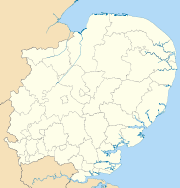
Hertfordshire Bedfordshire Cambridgeshire Norfolk Breckland • Broadland • Great Yarmouth • King's Lynn and West Norfolk • North Norfolk • Norwich • South Norfolk
Suffolk Cities of the United Kingdom England Bath · Birmingham · Bradford · Brighton and Hove · Bristol · Cambridge · Canterbury · Carlisle · Chester · Chichester · Coventry · Derby · Durham · Ely · Exeter · Gloucester · Hereford · Kingston upon Hull · Lancaster · Leeds · Leicester · Lichfield · Lincoln · Liverpool · London · Manchester · Newcastle upon Tyne · Norwich · Nottingham · Oxford · Peterborough · Plymouth · Portsmouth · Preston · Ripon · St Albans · Salford · Salisbury · Sheffield · Southampton · Stoke-on-Trent · Sunderland · Truro · Wakefield · Wells · Westminster · Winchester · Wolverhampton · Worcester · York
Scotland Wales Northern Ireland Categories:- Cities in the East of England
- County towns in England
- Norwich
- Non-metropolitan districts of Norfolk
- Local government districts of the East of England
Wikimedia Foundation. 2010.

